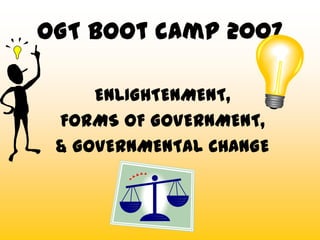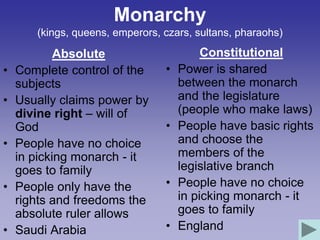Forms of Government
- 1. OGT Boot camp 2007 ENLIGHTENMENT, FORMS OF GOVERNMENT, & GOVERNMENTAL CHANGE
- 2. Monarchy (kings, queens, emperors, czars, sultans, pharaohs) Absolute Constitutional âĒ Complete control of the âĒ Power is shared subjects between the monarch âĒ Usually claims power by and the legislature divine right â will of (people who make laws) God âĒ People have basic rights âĒ People have no choice and choose the in picking monarch - it members of the goes to family legislative branch âĒ People only have the âĒ People have no choice rights and freedoms the in picking monarch - it absolute ruler allows goes to family âĒ Saudi Arabia âĒ England
- 3. Democracy Presidential Parliamentary âĒ Both the executive âĒ Voters elect the branch (President) & the legislative branch legislative branch (parliament). The (Congress) are elected Parliament picks the by the people and executive branch (Prime answer to the people Minister), and appoints âĒ The judicial branch the judicial branch. (Supreme Court) gets âĒ Canada, United appointed by the other Kingdom two branches âĒ United States
- 4. Dictatorship & Theocracy Dictatorship Theocracy âĒ A single person or small âĒ The leader of the major group of people exercise religion is the leader of supreme power over government others âĒ Leader claims God gave âĒ Dictator will take control him or her the power to by force or is appointed govern and takes his power âĒ Iran, Vatican after âĒ Cuba, North Korea, Old Iraq, WW2 Germany



